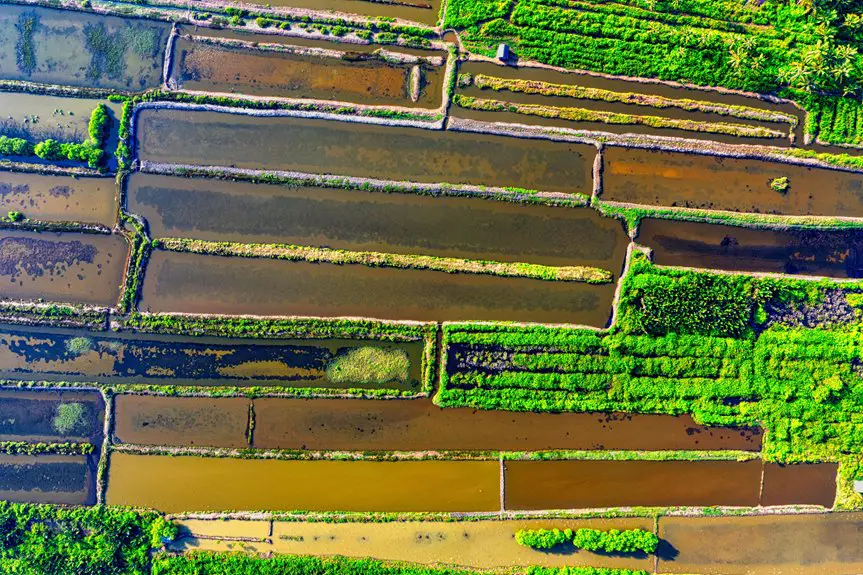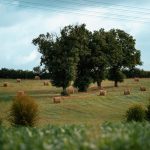You use geotextiles to strengthen soil and prevent erosion, which keeps your construction projects stable and durable. They help improve drainage by letting water pass while stopping sediment from causing blockages. Geotextiles also reinforce roadways and pavements to extend their lifespan and reduce maintenance costs. In landscaping, they protect slopes and promote healthy plant growth. Plus, they play a key role in managing stormwater and protecting the environment. There’s plenty more to discover about their benefits.
Table of Contents
Key Takeaways
- Geotextiles reinforce soil stability, preventing displacement and reducing settlement risks during construction.
- They improve drainage by filtering soil particles and allowing water to flow while preventing erosion.
- Geotextiles strengthen roadways and pavements by distributing loads and separating soil layers, extending their lifespan.
- They prevent soil erosion on slopes and embankments, supporting healthy vegetation growth and landscape integrity.
- Geotextiles control sediment runoff and filter pollutants, protecting waterways and enhancing environmental health.
Enhancing Soil Stability in Construction
When you reinforce soil with geotextiles, you considerably boost its stability during construction. These synthetic fabrics distribute loads more evenly, preventing soil displacement and reducing settlement risks.
Reinforcing soil with geotextiles enhances stability by evenly distributing loads and minimizing settlement risks.
You’ll find they separate different soil layers, stopping fine particles from mixing with coarser ones, which keeps the foundation firm. By strengthening weak soils, geotextiles help you build on challenging terrains without expensive soil replacement.
They also improve drainage, allowing water to flow through while maintaining soil integrity, which cuts down on pressure buildup. Using geotextiles, you can guarantee safer, longer-lasting structures by controlling soil movement under heavy loads.
This method is cost-effective, speeds up construction, and minimizes environmental impact, making it a smart choice when you want reliable soil performance on your project site.
Effective Erosion Control Methods
Although erosion can rapidly degrade landscapes and structures, you can effectively control it using several proven methods. One key approach is planting vegetation, which anchors soil with roots and reduces runoff speed.
You should also consider installing geotextiles; these fabrics stabilize soil, prevent displacement, and allow water to pass through, minimizing erosion without blocking drainage. Another method involves creating physical barriers like silt fences or retaining walls to hold soil in place during heavy rain.
Additionally, contour plowing or terracing slopes can slow water flow and reduce soil loss. By combining these strategies thoughtfully, you’ll maintain soil integrity and protect your land from the damaging effects of erosion, ensuring long-term stability and sustainability for your projects.
Improving Drainage Systems
When you use geotextiles, you boost water flow and stop soil from washing away.
They also help keep your drainage structures strong and stable.
Let’s explore how these benefits improve your drainage systems.
Enhancing Water Flow
Since proper drainage is essential for preventing water accumulation and structural damage, using geotextiles can greatly enhance water flow in your drainage systems.
These fabrics act as filters, allowing water to pass while keeping soil and debris out, which prevents clogging. You’ll find that installing geotextiles improves the efficiency and lifespan of drainage pipes and channels.
They also help maintain soil stability around drainage areas, avoiding blockages caused by soil movement.
Here’s how geotextiles enhance water flow:
- Filter fine particles to prevent pipe clogging
- Promote even water distribution through drainage layers
- Maintain separation between soil and drainage materials
Preventing Soil Erosion
Beyond enhancing water flow, geotextiles play an essential role in preventing soil erosion around drainage systems.
When you install geotextile fabric, it stabilizes the soil by holding particles in place while allowing water to pass through. This filtration prevents soil from washing away, especially during heavy rain or flooding.
By using geotextiles, you reduce sediment buildup in drains, which keeps your drainage system functioning efficiently. You also protect nearby landscapes from erosion damage, preserving the integrity of slopes and embankments.
Incorporating geotextiles helps maintain a balance between drainage and soil stability, so you won’t have to worry about costly repairs caused by soil loss.
In short, geotextiles give you a reliable, low-maintenance solution to control erosion and improve your drainage system’s longevity.
Supporting Structural Integrity
Although soil stability is essential, supporting the overall structural integrity of your drainage system is equally important. Geotextiles help by reinforcing the soil, distributing loads evenly, and preventing the collapse of drainage trenches or channels.
They act as a barrier that keeps soil particles in place while allowing water to flow freely, which preserves the system’s function over time.
By using geotextiles, you can:
- Enhance load-bearing capacity, reducing settlement risks
- Maintain separation between soil layers, preventing contamination
- Improve filtration, ensuring efficient water flow without clogging
Incorporating geotextiles in your drainage design means you’ll have a more durable, reliable system that stands up to environmental stress and heavy usage.
Reinforcement of Roadways and Pavements
When you reinforce roadways and pavements with geotextiles, you enhance their strength and durability considerably. Geotextiles distribute loads more evenly across the surface, reducing stress on weak subgrades and preventing rutting or cracking.
By separating different soil layers, they stop contamination and maintain the pavement’s structural integrity over time. You’ll find that geotextiles improve drainage, too, which helps avoid water buildup that can weaken the base and cause premature failures.
Using geotextiles also extends the lifespan of roads and pavements, reducing maintenance costs and downtime. Whether you’re working on highways, parking lots, or residential streets, incorporating geotextiles into your construction process gives you a more stable, long-lasting surface that stands up to heavy traffic and environmental challenges.
Applications in Landscaping Projects
Geotextiles play an essential role in landscaping projects by improving soil stability and controlling erosion. When you’re working on a garden or outdoor space, using geotextile fabric can prevent soil from washing away during heavy rains.
It also helps you separate different layers of soil or gravel, ensuring your landscape stays intact and looks neat. You’ll find they’re especially useful in areas with slopes or uneven terrain.
Here’s how you can use geotextiles in landscaping:
- Preventing soil erosion on slopes and embankments
- Stabilizing pathways and driveways by separating soil and aggregate
- Promoting healthy plant growth by improving drainage and soil structure
Use in Retaining Wall Construction
Because retaining walls must withstand significant pressure from soil and water, using geotextile fabric can greatly enhance their durability.
When you build or reinforce a retaining wall, placing geotextile between the soil and the wall helps separate materials and improves drainage. This prevents soil from washing out while allowing water to pass through, reducing hydrostatic pressure that can cause wall failure.
You’ll also find that geotextiles stabilize the soil behind the wall, distributing loads more evenly and minimizing settling or shifting over time.
By incorporating geotextile fabric, you’re effectively extending the lifespan of your retaining wall, ensuring it remains strong and stable under varying conditions.
It’s a simple, cost-effective step that adds significant structural integrity to your project.
Benefits for Slope Protection
Just as geotextile fabric strengthens retaining walls by managing soil and water pressure, it also plays an essential role in protecting slopes from erosion and instability.
When you use geotextile on slopes, it helps keep soil in place, preventing washouts during heavy rains. It also improves slope durability by allowing water to drain while keeping soil particles from moving. This means your slopes stay stable longer, reducing maintenance needs.
Here’s how geotextile benefits slope protection:
- Prevents soil erosion by reinforcing the surface
- Enhances drainage, reducing water buildup and pressure
- Increases slope stability by holding soil layers together
Role in Stormwater Management
When managing stormwater, you’ll find geotextiles play a key role in enhancing water filtration and preventing soil erosion.
They help improve drainage efficiency by allowing water to pass while keeping soil in place.
Understanding how these fabrics work can boost your project’s durability and effectiveness.
Enhancing Water Filtration
Although stormwater can carry harmful sediments and pollutants, geotextiles play an essential role in enhancing water filtration to protect downstream ecosystems.
When you use geotextiles, they act as a barrier that lets water pass while trapping sediment and debris. This filtration helps keep waterways cleaner and reduces the risk of contamination. You’ll find geotextiles especially useful in areas with heavy runoff or construction sites where sediment control is critical.
Their porous structure maintains water flow but filters out unwanted particles effectively.
Here’s how geotextiles improve water filtration:
- Capture suspended solids before water reaches natural bodies
- Maintain soil stability under filtration layers
- Allow consistent drainage without clogging
Preventing Soil Erosion
Since stormwater can quickly wash away exposed soil, using geotextiles helps you prevent soil erosion effectively.
When heavy rain hits, the fabric acts as a protective barrier that holds soil in place, reducing the risk of sediment loss. You’ll find it especially useful on slopes, embankments, or areas with loose soil, where erosion is most likely to occur.
Geotextiles stabilize the ground by distributing water flow evenly, preventing the formation of gullies or washouts. By installing geotextiles, you also protect nearby water bodies from sediment pollution caused by runoff.
This means you’re not only preserving your land but also supporting environmental health. Overall, geotextiles give you a smart, durable solution to keep soil intact during stormwater events.
Improving Drainage Efficiency
Because stormwater can overwhelm drainage systems and cause flooding, geotextiles play an essential role in improving drainage efficiency. When you use geotextiles, you help filter water while keeping soil and debris out of drainage pipes and channels. This prevents blockages and allows water to flow freely, reducing the risk of backups and flooding.
Geotextiles also distribute water evenly, which avoids localized saturation and soil instability. By incorporating them into your stormwater management plan, you enhance the system’s longevity and effectiveness.
Here’s how geotextiles help with drainage:
- Filter soil particles to prevent clogging
- Promote uniform water flow and distribution
- Protect drainage infrastructure from sediment damage
Using geotextiles means you’re investing in a reliable, efficient drainage system.
Extending the Lifespan of Infrastructure
When you integrate geotextiles into construction projects, you actively strengthen infrastructure and greatly extend its lifespan.
Geotextiles act as a stabilizing layer, preventing soil erosion and reducing settlement under roads, bridges, and embankments. This reinforcement minimizes cracks and structural damage caused by shifting soil or water infiltration.
You also benefit from their ability to separate different soil layers, maintaining the integrity of foundations and pavements over time. By controlling moisture movement and distributing loads evenly, geotextiles reduce maintenance needs and prevent premature failure.
Using geotextiles means your infrastructure stands stronger against environmental stresses, allowing you to avoid costly repairs and replacements.
In short, geotextiles help you build durable, long-lasting structures that perform reliably for years.
Environmental Advantages of Geotextiles
You’ll see how geotextiles play a key role in preventing erosion by holding soil in place during heavy rains.
They also help stabilize soil, reducing the risk of landslides and improving plant growth.
Understanding these benefits shows why geotextiles are essential for protecting the environment.
Erosion Control Benefits
Although soil erosion poses significant environmental challenges, geotextiles offer an effective solution by stabilizing soil and preventing sediment loss.
When you use geotextiles, you control erosion by protecting the soil surface from water and wind forces that wash or blow soil away. These fabrics act as barriers, allowing water to pass while holding soil particles in place, which helps maintain the land’s integrity and reduces environmental damage.
By incorporating geotextiles, you’ll benefit from:
- Reduced sediment runoff into waterways, protecting aquatic ecosystems
- Minimized loss of fertile topsoil, preserving land productivity
- Controlled surface water flow, preventing gullies and rills from forming
Using geotextiles is a smart, eco-friendly way to manage erosion and safeguard your land.
Soil Stabilization Effects
Geotextiles enhance soil stability by reinforcing the ground and distributing loads more evenly, which prevents soil displacement and structural failures.
When you use geotextiles, you create a stronger foundation that supports heavy traffic or construction activities without causing soil erosion. They act as separators, stopping different soil layers from mixing and maintaining soil integrity. This means you won’t face issues like uneven settling or soil weakening over time.
Additionally, geotextiles improve drainage by allowing water to pass through while holding soil particles in place, reducing waterlogging and related damage.
Frequently Asked Questions
What Materials Are Geotextiles Typically Made From?
You’ll find geotextiles typically made from synthetic materials like polypropylene or polyester. These fibers are woven, non-woven, or knitted, giving you durability and flexibility for various construction, drainage, and erosion control projects.
How Long Do Geotextiles Usually Last Underground?
You can expect geotextiles to last underground anywhere from 10 to 50 years, depending on the material type, soil conditions, and exposure to chemicals or UV light. Proper installation helps maximize their lifespan.
Can Geotextiles Be Recycled or Reused?
You can recycle some geotextiles, especially those made from polypropylene or polyester, but it depends on contamination and condition. Reusing them is possible if they remain intact and clean, but it’s less common in practice.
Are Geotextiles Safe for Planting Around Edible Crops?
You can safely use geotextiles around edible crops if you choose food-grade, non-toxic types. They help control weeds and improve soil stability without harming your plants or contaminating your harvest.
What Are the Different Types of Geotextiles Available?
Did you know geotextiles reduce soil erosion by up to 90%? You’ll find woven, non-woven, and knitted types, each designed for specific uses like filtration, separation, or reinforcement in your projects.
- Does Chiffon Fabric Stink - July 15, 2025
- Does Chiffon Fabric Affect the Economy - July 15, 2025
- Does Cotton Fabric Have a Nap - July 15, 2025







